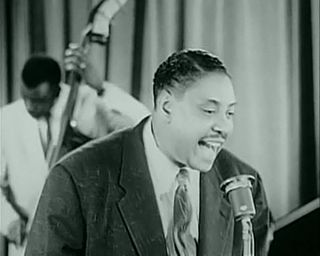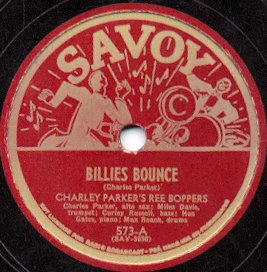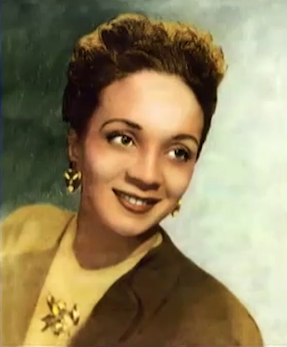Related Research Articles

Funk is a music genre that originated in African American communities in the mid-1960s when musicians created a rhythmic, danceable new form of music through a mixture of various music genres that were popular among African-Americans in the mid-20th century. It deemphasizes melody and chord progressions and focuses on a strong rhythmic groove of a bassline played by an electric bassist and a drum part played by a percussionist, often at slower tempos than other popular music. Funk typically consists of a complex percussive groove with rhythm instruments playing interlocking grooves that create a "hypnotic" and "danceable" feel. It uses the same richly colored extended chords found in bebop jazz, such as minor chords with added sevenths and elevenths, and dominant seventh chords with altered ninths and thirteenths.
Jazz is a music genre that originated in the African-American communities of New Orleans, Louisiana, in the late 19th and early 20th centuries, with its roots in blues and ragtime. Since the 1920s Jazz Age, it has been recognized as a major form of musical expression in traditional and popular music. Jazz is characterized by swing and blue notes, complex chords, call and response vocals, polyrhythms and improvisation. Jazz has roots in European harmony and African rhythmic rituals.
Rock and roll is a genre of popular music that evolved in the United States during the late 1940s and early 1950s. It originated from African-American music such as jazz, rhythm and blues, boogie-woogie, electric blues, gospel, jump blues, as well as country music. While rock and roll's formative elements can be heard in blues records from the 1920s and in country records of the 1930s, the genre did not acquire its name until 1954.

Rhythm and blues, frequently abbreviated as R&B or R'n'B, is a genre of popular music that originated within African-American communities in the 1940s. The term was originally used by record companies to describe recordings marketed predominantly to African Americans, at a time when "rocking, jazz based music ... [with a] heavy, insistent beat" was becoming more popular. In the commercial rhythm and blues music typical of the 1950s through the 1970s, the bands usually consisted of a piano, one or two guitars, bass, drums, one or more saxophones, and sometimes background vocalists. R&B lyrical themes often encapsulate the African-American history and experience of pain and the quest for freedom and joy, as well as triumphs and failures in terms of societal racism, oppression, relationships, economics, and aspirations.

A jazz band is a musical ensemble that plays jazz music. Jazz bands vary in the quantity of its members and the style of jazz that they play but it is common to find a jazz band made up of a rhythm section and a horn section.

A big band or jazz orchestra is a type of musical ensemble of jazz music that usually consists of ten or more musicians with four sections: saxophones, trumpets, trombones, and a rhythm section. Big bands originated during the early 1910s and dominated jazz in the early 1940s when swing was most popular. The term "big band" is also used to describe a genre of music, although this was not the only style of music played by big bands.

Lionel Leo Hampton was an American jazz vibraphonist, pianist, percussionist, and bandleader. Hampton worked with jazz musicians from Teddy Wilson, Benny Goodman, and Buddy Rich, to Charlie Parker, Charles Mingus, and Quincy Jones. In 1992, he was inducted into the Alabama Jazz Hall of Fame, and he was awarded the National Medal of Arts in 1996.

Doo-wop is a genre of rhythm and blues music that originated in African-American communities during the 1940s, mainly in the large cities of the United States, including New York, Philadelphia, Pittsburgh, Chicago, Baltimore, Newark, Detroit, Washington, D.C., and Los Angeles. It features vocal group harmony that carries an engaging melodic line to a simple beat with little or no instrumentation. Lyrics are simple, usually about love, sung by a lead vocal over background vocals, and often featuring, in the bridge, a melodramatically heartfelt recitative addressed to the beloved. Harmonic singing of nonsense syllables is a common characteristic of these songs. Gaining popularity in the 1950s, doo-wop was "artistically and commercially viable" until the early 1960s, but continued to influence performers in other genres.
Jump blues is an up-tempo style of blues, jazz, and boogie woogie usually played by small groups and featuring horn instruments. It was popular in the 1940s and was a precursor of rhythm and blues and rock and roll. Appreciation of jump blues was renewed in the 1990s as part of the swing revival.

The Jazz Age was a period in the 1920s and 1930s in which jazz music and dance styles gained worldwide popularity. The Jazz Age's cultural repercussions were primarily felt in the United States, the birthplace of jazz. Originating in New Orleans as mainly sourced from the culture of African Americans, jazz played a significant part in wider cultural changes in this period, and its influence on popular culture continued long afterwards.

Savoy Records is an American record company and label established by Herman Lubinsky in 1942 in Newark, New Jersey. Savoy specialized in jazz, rhythm and blues, and gospel music.
Marjorie Hyams was an American jazz vibraphonist, pianist, and arranger. She began her career as a vibraphonist in the 1940s, playing with Woody Herman, the Hip Chicks (1945), Mary Lou Williams (1946), Charlie Ventura (1946), George Shearing, and led her own groups, including a trio, which stayed together from 1945 to 1948, performing on 52nd Street in Manhattan. The media, marquees, and promos often spelled her first name "Margie", but she insisted that it was spelled with a "j".
The International Sweethearts of Rhythm was the first integrated all-women's band in the United States. During the 1940s the band featured some of the best female musicians of the day. They played swing and jazz on a national circuit that included the Apollo Theater in New York City, the Regal Theater in Chicago, and the Howard Theater in Washington, D.C. After a performance in Chicago in 1943, the Chicago Defender announced the band was "one of the hottest stage shows that ever raised the roof of the theater!" They have been labeled "the most prominent and probably best female aggregation of the Big Band era". During feminist movements of the 1960s and 1970s in America, the International Sweethearts of Rhythm became popular with feminist writers and musicologists who made it their goal to change the discourse on the history of jazz to include both men and women musicians. Flutist Antoinette Handy was one scholar who documented the story of these female musicians of color.
Dixieland jazz, also referred to as traditional jazz, hot jazz, or simply Dixieland, is a style of jazz based on the music that developed in New Orleans at the start of the 20th century. The 1917 recordings by the Original Dixieland Jass Band, fostered awareness of this new style of music.
The Darlings of Rhythm was an African American, all-female swing band from the 1940s.
The Harlem Playgirls was an African American swing band active in the Midwest and throughout the United States from the mid-1930s to the early 1940s.
There were two independently created and independently operating groups known as the Melodears or Melo-Dears in the 1930s and 1940s, one a band, the other a vocal trio, with similar names only by coincidence. There is no known connection between the two groups. There was, as well, a musical variety group in Ventura, California, with the same name, led by Kae Herron in the 1970s and 1980s.
Pauline Braddy Williams was an American jazz drummer. She drummed with the International Sweethearts of Rhythm, an integrated, all-female swing band, from 1939 to 1955; Braddy herself was African-American. Braddy was known as "Queen of the Drums".

Ann Baker was an American jazz singer. Baker was discovered by Louie Armstrong and played with his band on Broadway. She is best known for her time spent as a member of Billy Eckstine's band, "The Dream Band" where she performed with Charlie Parker, Dizzy Gillespie, Dexter Gordon, Miles Davis and Art Blakey.

International Sweethearts of Rhythm: America's Hottest All-Girl Band is a 1986 American independent short documentary film directed and produced by Greta Schiller and Andrea Weiss that presents a history of the International Sweethearts of Rhythm, the first racially integrated all-female jazz band in the United States.
References
- ↑ Women and music in America since 1900 . Greenwood Press. 2002. p. 2002. ISBN 1573563080 . Retrieved 21 August 2019.
- 1 2 McGee, Kristin A. (2009). Some Liked It Hot: Jazz Women in Film and Television, 1928-1959. Wesleyan University Press. p. 56. ISBN 978-0819569677.
- ↑ Handy, D. Antoinette (1998). Black Women in American Bands and Orchestras. Scarecrow Press. p. 44. ISBN 0810834197 . Retrieved 21 August 2019.